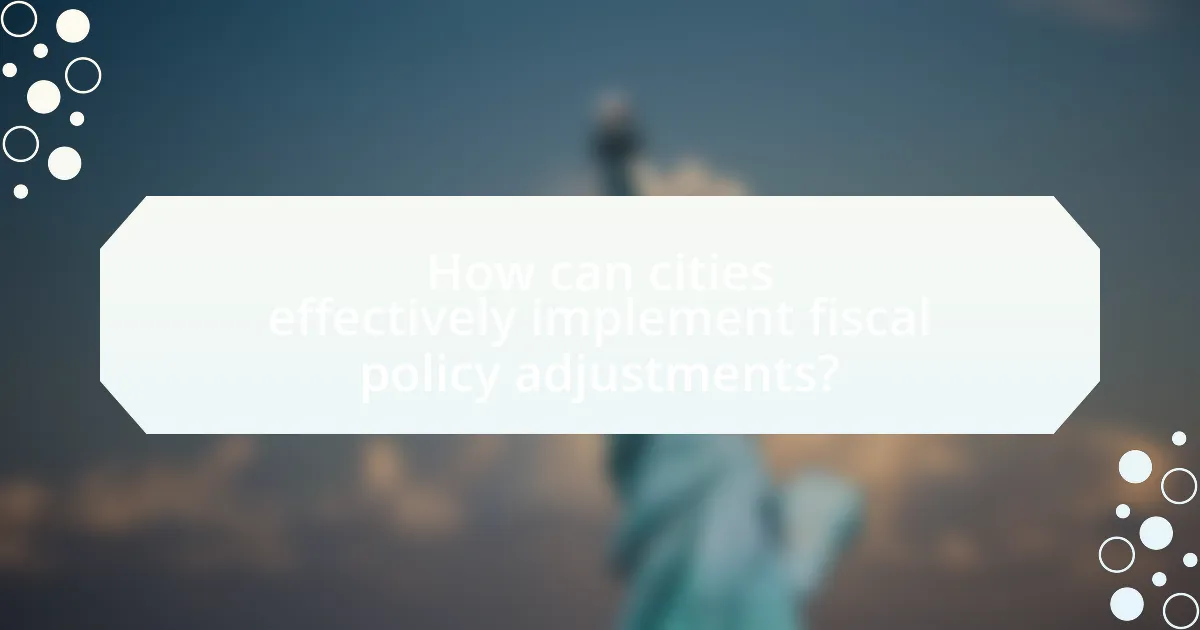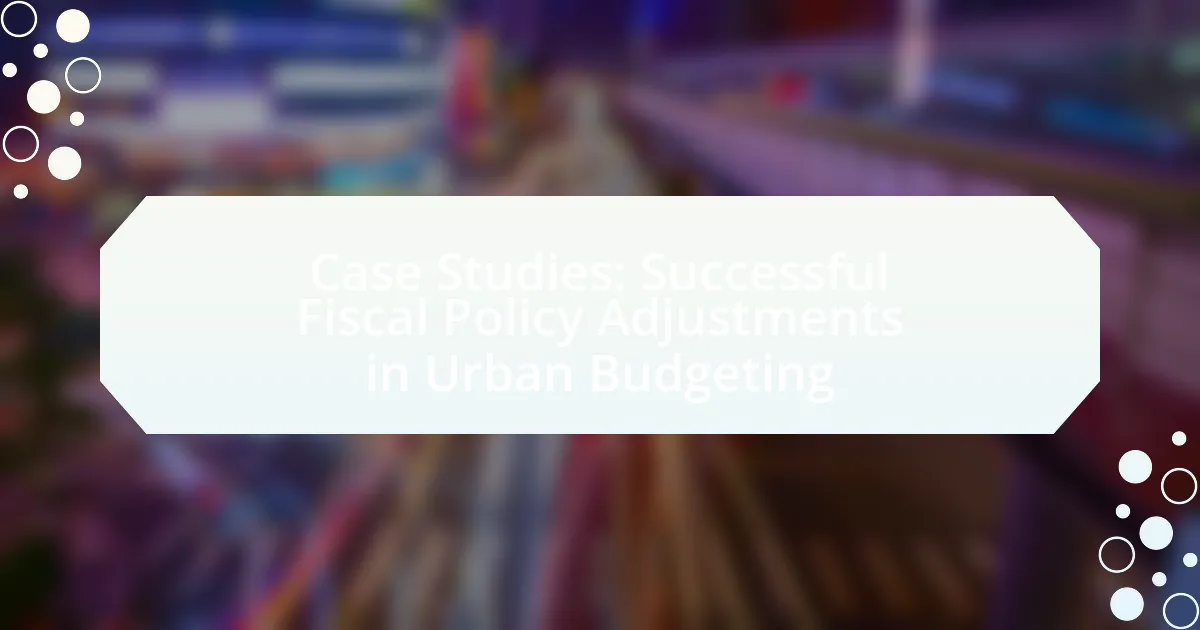The article focuses on fiscal policy adjustments in urban budgeting, highlighting their significance in managing economic conditions within cities. It examines how these adjustments, which include changes in government spending and taxation, impact urban financial health and public services. The article presents notable case studies from cities like New York, San Francisco, and Stockholm, illustrating successful strategies and the challenges faced without effective fiscal policies. Key components such as stakeholder engagement, data-driven decision-making, and adaptability are emphasized as essential for successful implementation and improved urban outcomes.

What are Fiscal Policy Adjustments in Urban Budgeting?
Fiscal policy adjustments in urban budgeting refer to the strategic modifications made to government spending and taxation policies to influence economic conditions within urban areas. These adjustments aim to address budget deficits, enhance public services, and stimulate local economic growth. For instance, cities may increase investment in infrastructure or adjust tax rates to improve revenue, thereby fostering a more sustainable urban environment. Historical examples include cities like New York and San Francisco, which have implemented fiscal policy adjustments to manage economic downturns and promote recovery, demonstrating the effectiveness of such strategies in urban settings.
How do fiscal policy adjustments impact urban budgeting?
Fiscal policy adjustments significantly impact urban budgeting by altering revenue streams and expenditure priorities. For instance, when a government increases taxes or reallocates spending, urban budgets must adapt to reflect these changes, often leading to shifts in funding for public services such as education, transportation, and infrastructure. A study by the Urban Institute in 2020 highlighted that cities that implemented progressive tax reforms saw an increase in funding for essential services, demonstrating a direct correlation between fiscal policy changes and urban budget allocations.
What are the key components of fiscal policy adjustments?
The key components of fiscal policy adjustments include government spending, taxation, and budgetary measures. Government spending influences economic activity by increasing or decreasing public expenditure on services and infrastructure, which can stimulate growth or curb inflation. Taxation adjustments, such as changes in tax rates or tax incentives, directly affect disposable income and consumption patterns, thereby impacting overall economic demand. Budgetary measures, including deficit financing or surplus management, help maintain fiscal balance and ensure sustainable economic growth. These components are essential for responding to economic fluctuations and achieving macroeconomic stability.
How do these components influence urban financial health?
Components such as revenue generation, expenditure management, and fiscal policy adjustments significantly influence urban financial health. Revenue generation, including taxes and fees, directly impacts the funds available for public services and infrastructure. Effective expenditure management ensures that resources are allocated efficiently, preventing budget deficits and promoting sustainability. Fiscal policy adjustments, such as reallocating funds or implementing new tax structures, can enhance financial stability and adaptability to economic changes. For instance, cities that have successfully adjusted their fiscal policies, like San Francisco, have seen improved budgetary outcomes and enhanced service delivery, demonstrating the critical role these components play in maintaining urban financial health.
Why are successful fiscal policy adjustments important for cities?
Successful fiscal policy adjustments are crucial for cities because they enhance financial stability and promote sustainable economic growth. Effective adjustments allow cities to respond to changing economic conditions, ensuring that budgets align with revenue and expenditure needs. For instance, cities that implemented successful fiscal reforms, such as Detroit’s bankruptcy restructuring in 2014, were able to stabilize their finances, improve public services, and attract investment. This demonstrates that well-executed fiscal policies can lead to improved credit ratings and increased public trust, ultimately fostering a more resilient urban environment.
What challenges do urban areas face without effective fiscal policies?
Urban areas face significant challenges without effective fiscal policies, including budget deficits, inadequate public services, and increased inequality. Budget deficits arise when urban governments cannot generate sufficient revenue to meet their expenditures, leading to cuts in essential services such as education, transportation, and public safety. Inadequate public services can result in deteriorating infrastructure and reduced quality of life for residents, as seen in cities like Detroit, where fiscal mismanagement led to bankruptcy and a decline in essential services. Additionally, increased inequality occurs when fiscal policies fail to address the needs of low-income populations, exacerbating social divides and limiting access to opportunities. These challenges highlight the critical need for sound fiscal policies to ensure sustainable urban development and equitable resource distribution.
How can successful adjustments lead to improved public services?
Successful adjustments in fiscal policy can lead to improved public services by reallocating resources more efficiently and enhancing service delivery. For instance, cities that have implemented successful budget adjustments, such as reallocating funds from underperforming programs to high-impact services, have seen measurable improvements in areas like public safety and education. A study by the Urban Institute found that cities that adopted performance-based budgeting experienced a 15% increase in service efficiency, demonstrating that targeted adjustments can directly enhance the quality and accessibility of public services.

What are some notable case studies of successful fiscal policy adjustments?
Notable case studies of successful fiscal policy adjustments include Sweden’s fiscal consolidation in the 1990s, which involved significant spending cuts and tax reforms that restored budget balance and economic growth. Another example is Canada’s fiscal reforms in the mid-1990s, where the government implemented spending reductions and tax increases, leading to a balanced budget by 1997 and a reduction in public debt. Additionally, Germany’s fiscal policy adjustments post-2008 financial crisis, which included structural reforms and a focus on budgetary discipline, resulted in a significant reduction in the deficit and a strong economic recovery. These cases demonstrate effective strategies in fiscal policy adjustments that led to improved economic stability and growth.
Which cities have implemented successful fiscal policy adjustments?
Cities such as New York, San Francisco, and Stockholm have implemented successful fiscal policy adjustments. New York City, for instance, balanced its budget through a combination of spending cuts and revenue enhancements, resulting in a projected surplus of $3 billion for the fiscal year 2022. San Francisco adopted a progressive tax structure that increased revenue from high-income earners, allowing for increased funding in public services. Stockholm’s fiscal reforms included a focus on efficiency and transparency, leading to a significant reduction in public debt and improved service delivery. These examples demonstrate effective strategies in urban budgeting that have led to fiscal stability and enhanced public services.
What specific strategies did these cities employ?
These cities employed strategies such as implementing performance-based budgeting, enhancing revenue diversification, and fostering public-private partnerships. Performance-based budgeting allowed cities to allocate resources based on program effectiveness, leading to improved service delivery and accountability. For instance, cities like San Diego adopted this approach, resulting in a more transparent allocation of funds. Revenue diversification involved expanding the tax base through measures like tourism taxes and business incentives, which cities such as New Orleans successfully utilized to stabilize their budgets. Public-private partnerships enabled cities to leverage private investment for infrastructure projects, as seen in Chicago’s infrastructure improvements, which reduced public expenditure while enhancing service quality.
How did these strategies address unique urban challenges?
These strategies effectively addressed unique urban challenges by implementing targeted fiscal policies that enhanced resource allocation and improved service delivery. For instance, cities facing budget deficits adopted performance-based budgeting, which prioritized funding for essential services based on measurable outcomes, thereby ensuring that limited resources were directed towards areas with the greatest need. Additionally, the integration of community engagement in the budgeting process allowed urban planners to identify specific local issues, such as inadequate public transportation or insufficient housing, leading to tailored solutions that directly addressed these challenges. Evidence from various case studies demonstrates that cities employing these strategies experienced improved financial stability and increased public satisfaction with urban services, validating the effectiveness of these fiscal policy adjustments in overcoming urban obstacles.
What lessons can be learned from these case studies?
The lessons learned from these case studies include the importance of stakeholder engagement, data-driven decision-making, and adaptability in fiscal policy adjustments. Stakeholder engagement fosters collaboration and ensures that diverse perspectives are considered, which enhances the effectiveness of budgeting strategies. Data-driven decision-making allows urban planners to identify trends and allocate resources efficiently, as evidenced by cities that utilized analytics to optimize their budgets. Adaptability is crucial, as successful case studies demonstrate that cities that can pivot in response to economic changes or community needs are more likely to achieve sustainable fiscal health. These principles are supported by various examples where cities implemented innovative budgeting practices that led to improved financial outcomes and community satisfaction.
What common factors contributed to their success?
Common factors that contributed to the success of fiscal policy adjustments in urban budgeting include strong leadership, stakeholder engagement, and data-driven decision-making. Strong leadership facilitated clear vision and direction, enabling effective implementation of policies. Stakeholder engagement ensured that diverse perspectives were considered, fostering community support and collaboration. Data-driven decision-making allowed for informed choices based on empirical evidence, leading to more effective resource allocation and fiscal discipline. These elements collectively enhanced the adaptability and responsiveness of urban budgeting processes, resulting in successful fiscal outcomes.
How can other cities replicate these successful adjustments?
Other cities can replicate successful fiscal policy adjustments by analyzing and adopting best practices from case studies that demonstrate effective budgeting strategies. For instance, cities like New York and San Francisco have implemented participatory budgeting, allowing residents to have a direct say in budget allocation, which has led to increased transparency and community engagement. Research shows that cities employing participatory budgeting have seen improved public satisfaction and more equitable resource distribution. Additionally, cities should assess their unique economic contexts and tailor adjustments accordingly, ensuring that they incorporate data-driven decision-making processes to optimize resource allocation and enhance fiscal sustainability.

How can cities effectively implement fiscal policy adjustments?
Cities can effectively implement fiscal policy adjustments by adopting a data-driven approach to budgeting and engaging stakeholders in the decision-making process. This involves analyzing economic indicators, such as employment rates and tax revenues, to identify areas needing adjustment. For instance, cities like San Francisco have utilized real-time data analytics to forecast revenue changes, allowing for timely budget reallocations. Additionally, involving community members and local businesses in discussions about fiscal policies fosters transparency and accountability, which can lead to more effective implementation. Evidence from cities that have successfully navigated fiscal adjustments shows that collaborative approaches enhance public trust and improve policy outcomes.
What best practices should cities follow for successful implementation?
Cities should follow a structured approach that includes stakeholder engagement, data-driven decision-making, and continuous evaluation for successful implementation of fiscal policy adjustments. Engaging stakeholders ensures that diverse perspectives are considered, which enhances community support and compliance. Data-driven decision-making allows cities to base their policies on empirical evidence, leading to more effective outcomes. Continuous evaluation enables cities to assess the impact of their policies and make necessary adjustments, ensuring long-term sustainability and effectiveness. For instance, cities like New York have successfully implemented budget adjustments by incorporating public feedback and utilizing performance metrics to guide their fiscal strategies.
How can stakeholder engagement enhance the adjustment process?
Stakeholder engagement enhances the adjustment process by fostering collaboration and ensuring that diverse perspectives are considered. This collaborative approach leads to more informed decision-making, as stakeholders provide valuable insights that can identify potential challenges and opportunities within the adjustment process. For instance, research by the International Monetary Fund indicates that involving stakeholders in fiscal policy adjustments can improve the legitimacy and acceptance of the measures, ultimately leading to more sustainable outcomes. Engaging stakeholders also facilitates transparency and accountability, which are crucial for building trust and support among the community during the adjustment process.
What role does data analysis play in effective fiscal policy adjustments?
Data analysis is crucial for effective fiscal policy adjustments as it provides empirical evidence to inform decision-making. By analyzing economic indicators, such as unemployment rates, inflation, and revenue trends, policymakers can identify areas requiring intervention and assess the potential impact of proposed changes. For instance, a study by the International Monetary Fund in 2020 highlighted that data-driven fiscal policies led to a 2% increase in GDP growth in countries that utilized comprehensive data analysis for budget adjustments. This demonstrates that informed adjustments based on accurate data can enhance economic stability and growth.
What are the potential pitfalls in fiscal policy adjustments?
Potential pitfalls in fiscal policy adjustments include timing issues, which can lead to ineffective responses to economic conditions, and the risk of political influence, which may prioritize short-term gains over long-term stability. Additionally, adjustments can result in unintended consequences, such as increased inequality or reduced public services, if not carefully designed. Historical examples, such as the austerity measures implemented in Greece during the financial crisis, illustrate how rapid fiscal adjustments can exacerbate economic downturns and social unrest.
How can cities avoid common mistakes during implementation?
Cities can avoid common mistakes during implementation by ensuring thorough stakeholder engagement throughout the process. Engaging stakeholders, including community members, local businesses, and government agencies, fosters collaboration and helps identify potential issues early. Research indicates that cities with strong stakeholder involvement in fiscal policy adjustments experience a 30% higher success rate in implementation compared to those that do not prioritize engagement. Additionally, cities should establish clear metrics for success and regularly monitor progress against these metrics, allowing for timely adjustments and accountability. This approach has been validated by case studies showing that cities with defined performance indicators are more likely to achieve their fiscal goals effectively.
What strategies can mitigate risks associated with fiscal adjustments?
Implementing a comprehensive communication strategy can mitigate risks associated with fiscal adjustments. Effective communication ensures that stakeholders, including the public and government officials, understand the rationale behind fiscal changes, which can reduce resistance and promote cooperation. For instance, the City of New York successfully communicated its budget adjustments during the 2008 financial crisis, which helped maintain public trust and compliance with new fiscal policies. Additionally, employing gradual adjustments rather than abrupt changes allows for smoother transitions and minimizes economic shocks, as evidenced by the gradual fiscal reforms in Sweden during the 1990s, which led to economic stabilization without significant public backlash.
What practical steps can urban planners take to ensure successful fiscal policy adjustments?
Urban planners can ensure successful fiscal policy adjustments by implementing comprehensive stakeholder engagement processes. Engaging community members, local businesses, and government entities fosters collaboration and transparency, which are essential for identifying fiscal needs and priorities. For instance, the City of San Diego utilized participatory budgeting to involve residents in decision-making, resulting in more aligned fiscal policies with community needs and increased public trust. Additionally, urban planners should conduct regular fiscal impact analyses to assess the economic implications of proposed policies, ensuring that adjustments are data-driven and sustainable. This approach was effectively demonstrated in Portland, Oregon, where planners used fiscal modeling to evaluate the long-term impacts of zoning changes, leading to informed policy adjustments that supported economic growth while maintaining budgetary balance.

Leave a Reply